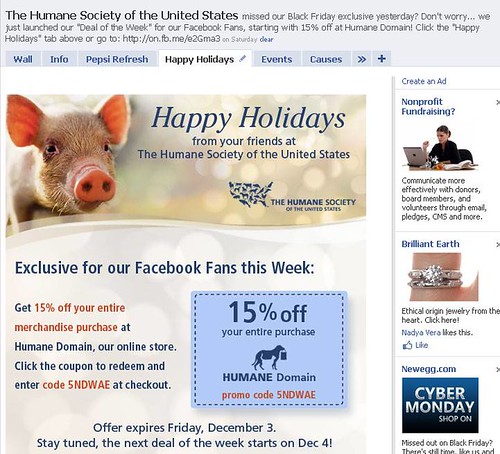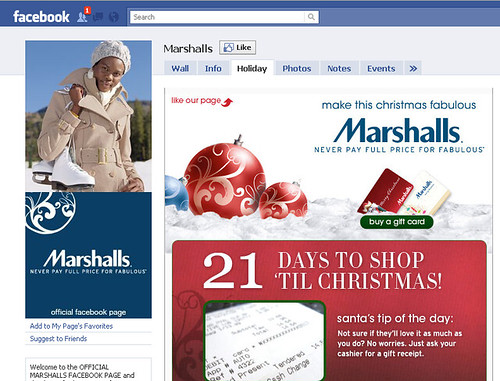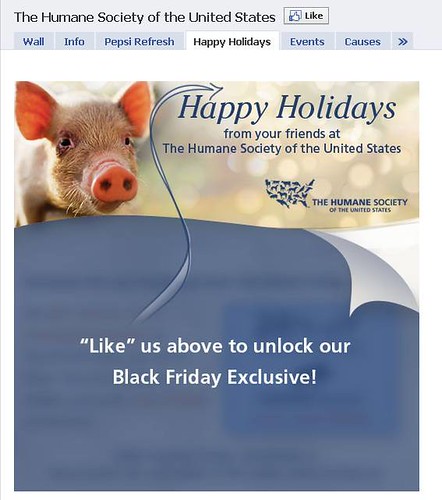
Note from Beth: Recently, Networked for Good offered a free e-book about how nonprofits can development a micro-content for their social media presences filled with useful tips and best practices. Carie Lewis gives an excellent mini case study of how to leverage micro content during the holiday and get results.
What is Your Nonprofit’s Holiday Content Strategy for Facebook? by Carie Lewis
At The Humane Society of the United States, we pride ourselves on on listening. But it’s not just about what people are saying about us. It’s also about what other organizations and businesses are doing and we gather this intelligence by reading blogs on these topics on a daily basis. Recently, I noticed a trend on what major retailers were doing on their Facebook pages for the holiday season. This post is how we could translate some of these tactics to nonprofit social media strategies.
Identifying a Trend
The emerging trend was that major retailers were using their Facebook pages to release special deals and give retail discounts for the holiday season. An article by CNET stated that approximately 31% of retailers planned to use their own websites to promote holiday deals, while 39% planned to use Facebook and 21% Twitter. Internet Retailer claims that the rules for Black Friday have changed significantly, and that many retailers are offering sneak peeks in advance on social networks to create buzz. It’s a brilliant strategy; use the fact that people love a deal to grow your base on social networks.
The Old Saying Is Still True. You Must Be Where People Are.
It’s important that nonprofits pay attention to emerging trends outside of our sector and think about how we can use this knowledge. It’s more about how people use social networks than what the sector is doing. A PC World article predicts that “What [retailers] are doing this year will be nothing compared to next year. Social media is evolving at near warp speed. Not because retailers are out in front of this–they are in fact racing to catch up to where their customers already are.” We must be where people are, and respond to the way they use social networks. Remember when Twitter realized people were using “RT” to repost other’s tweets, then made retweeting a permanent function of their platform?
Now What?
Every year, we do a holiday appeal that tells the story of animals who have survived horrible situations – puppy mills, dogfighting, and other forms of cruelty and neglect, and ask people to donate so we can continue that work. But we also have an online store and corporate partners that we promote during the holiday season, so we package all of this together in December. For two years, we’ve had a custom tab on our Facebook page that houses all this content. But this year, after noticing this trend of exclusivity on Facebook, I got a few new ideas.
The trick that retailers are starting to figure out, particularly with Black Friday this year, was making people “like” their page first in order to get the deal or coupon – not just having a fancy custom tab. It makes sense; you want these people to have a lasting relationship with you on Facebook. If they “like” you, they’ll continue to have a relationship with you long after they’ve used your special coupon code. Sure, they can always unlike you, but that’s the challenge: stay relevant and interesting enough to get people to stick with you. This made us take a step back and completely change the way we post to Facebook – less often, more engaging.
Implementation is the Hardest Part

To get started, I began researching examples of retailers that were using this tactic already on Facebook. Good examples I found were Borders, Marshalls, and Amazon.
I also came across an excellent whitepaper from Buddy Media about ways to engage fans on Facebook. One of the tactics they showcased was a company that showed a page turn image for non fans, and simulated the page turning when they became a fan, revealing exclusive content. The challenge was finding out how to make this happen on Facebook. To do this, you must use the Static FBML app on your Fan page as a custom tab. If you are already utilizing custom tabs on Facebook, then you’re ahead of the curve. They are a great way to put custom content on Facebook, but take some programming, using Facebook’s programming language called FBML. If you know CSS and/or HTML, you should be able to pick it up quickly.
(Note from Beth: Last week on the Zoetica Salon Zoetica Co-Founder, Kami Huyse, shared a post summarizing the discussion and how-tos for creating just such a landing tab)

Back to ROI
We gained 3,000 new fans the week of Black Friday, (three times our normal growth rate) most likely from our cross promotional efforts. We asked our Twitter followers if they “liked” us on Facebook and included transactional links on our holiday emails. Each had the angle of getting an exclusive deal when they joined us on Facebook. We’re going to launch accompanying Facebook ads next week as well. The advantage with Facebook ads is that you can target people with certain keywords in their profile (like “dogs”, for us) but that also are not already connected to our page. Once the promotions are over, we’ll also go back and find out how many people redeemed the coupon codes, and how much money we made from the deals.
An integrated campaign approach, along with ensuring that all of our holiday content is shareable, is the key social marketing strategy behind our holiday campaign. We’re continuing to update our Facebook tab as the holiday season progresses, so keep an eye on it!
What is your nonprofit’s holiday content strategy for Facebook? How has your organization celebrated other holidays on Facebook? Have a great example? Leave it in the comments.

Carie is the Director of Emerging Media at The Humane Society of the United States, leading social media campaigns to further the organization’s fundraising and advocacy goals. When she’s not in front of a computer, Carie enjoys being outside with her rescued pitbull, Bella. Find her on Twitter @cariegrls.
